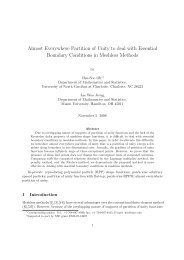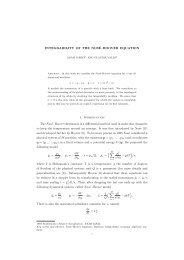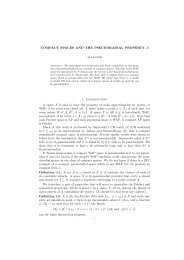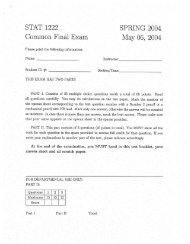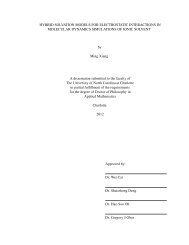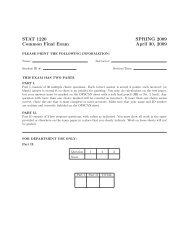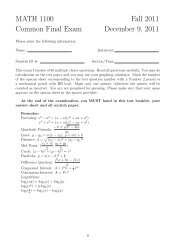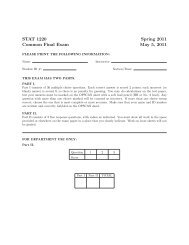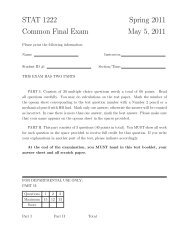LEVEL EULERIAN POSETS 1. Introduction It is the instinct of every ...
LEVEL EULERIAN POSETS 1. Introduction It is the instinct of every ...
LEVEL EULERIAN POSETS 1. Introduction It is the instinct of every ...
Create successful ePaper yourself
Turn your PDF publications into a flip-book with our unique Google optimized e-Paper software.
20 RICHARD EHRENBORG, GÁBOR HETYEI, AND MARGARET READDY<br />
Pro<strong>of</strong> <strong>of</strong> Theorem 7.4. Observe equation (7.2) <strong>is</strong> equivalent to<br />
(7.3) Ψ = K(a − b) + K(a − b) · b · Ψ.<br />
Consider <strong>the</strong> involution that exchanges <strong>the</strong> variables a and b. Note that th<strong>is</strong> involution leaves series<br />
expressed in c and d invariant. Apply th<strong>is</strong> involution to equation (7.3) gives<br />
(7.4) Ψ = K(b − a) + K(b − a) · a · Ψ.<br />
Add <strong>the</strong> two equations (7.3) and (7.4) and divide by 2.<br />
(7.5) Ψ = (K(a − b) + K(b − a))/2 + (K(a − b) · b + K(b − a) · a)/2 · Ψ.<br />
Divide <strong>the</strong> generating function K(t) into its even, respectively odd, generating function, that <strong>is</strong>, let<br />
K0(t) = K(√ t) + K(− √ t)<br />
2<br />
and K1(t) = K(√t) − K(− √ t)<br />
2 · √ .<br />
t<br />
We have K(t) = K0(t 2 ) + K1(t 2 ) · t and K(−t) = K0(t 2 ) − K1(t 2 ) · t. Note that<br />
(K(a − b) + K(b − a))/2 = K0(c 2 − 2 · d),<br />
(K(a − b) · b + K(b − a) · a)/2 = K0(c 2 − 2 · d) · c + K1(c 2 − 2 · d) · (2 · d − c 2 ).<br />
The result now follows since K0 and K1 are rational generating functions and we can solve for Ψ in<br />
equation (7.5). <br />
Bayer and Hetyei [5] proved that <strong>the</strong> ab-index <strong>of</strong> a half-Eulerian poset <strong>is</strong> a polynomial in <strong>the</strong> two<br />
variables a and (a − b) 2 . We now show th<strong>is</strong> also holds for <strong>the</strong> rational series <strong>of</strong> a level half-Eulerian<br />
poset. Define <strong>the</strong> algebra morph<strong>is</strong>m f↔ on R〈〈a, b〉〉 by f↔(a − b) = a − b and f↔(b) = 2b. <strong>It</strong> <strong>is</strong><br />
<strong>the</strong>n easy to observe from <strong>the</strong> chain definition (7.1) <strong>of</strong> <strong>the</strong> ab-index that for any poset P <strong>the</strong> ab-index<br />
<strong>of</strong> <strong>the</strong> poset P and its horizontal double are related by Ψ(D↔(P )) = f↔(Ψ(P )).<br />
Corollary 7.5. The ab-series Ψx,y <strong>of</strong> a level half-Eulerian poset <strong>is</strong> a rational generating function in<br />
<strong>the</strong> non-commutative variables a and (a − b) 2 .<br />
Pro<strong>of</strong>. Consider <strong>the</strong> horizontal double <strong>of</strong> <strong>the</strong> level half-Eulerian poset. <strong>It</strong>s ab-series <strong>is</strong> a rational<br />
generating function in terms <strong>of</strong> a + b = c and (a − b) 2 = c2 − 2d. The result follows by applying <strong>the</strong><br />
inverse morph<strong>is</strong>m f −1<br />
↔ to th<strong>is</strong> rational series. <br />
We similarly define <strong>the</strong> algebra morph<strong>is</strong>m f ↕ by f ↕(a − b) = (a − b) 2 and f ↕(b) = b(a − b) +<br />
(a − b)b + b 2 = ab + ba + b 2 . By <strong>the</strong> chain definition (7.1) <strong>of</strong> <strong>the</strong> ab-index we can conclude that<br />
Ψ(D ↕(P )) = f ↕(Ψ(P )). We end th<strong>is</strong> section by presenting <strong>the</strong> corresponding results for horizontaland<br />
vertical-doubling <strong>of</strong> a level poset. The pro<strong>of</strong> <strong>is</strong> straightforward and hence omitted.<br />
Proposition 7.6. Let P a level poset with underlying matrix M. Then we have<br />
<br />
f↔(Ψ(P )) f↔(Ψ(P ))<br />
Ψ(D↔(P )) =<br />
f↔(Ψ(P )) f↔(Ψ(P ))<br />
and<br />
Ψ(D ↕(P )) =<br />
<br />
a · f↕(Ψ(P )) I + a · f↕(Ψ(P )) · a<br />
,<br />
f↕(Ψ(P )) f↕(Ψ(P )) · a



